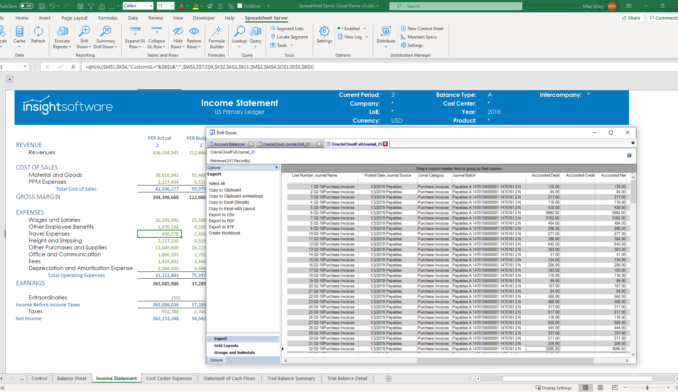If you love mixed martial arts (MMA), then you’ve encountered Zuffa, former parent company of the UFC. In just 12 years, Zuffa grew UFC’s fan base to 40 million people. Within a few more years, they predict they’ll more than double their numbers, nabbing as many fans as—or more than—the NBA.
When you’re a growing company, it’s only natural to outgrow things along the way. When you’re growing as fast as Zuffa, you burst out of old things the way the Incredible Hulk bursts out of Bruce Banner’s shirts. One technology that Zuffa outgrew but struggled to give up was its old friend, the humble static spreadsheet. Eventually, bidding farewell to static spreadsheets enabled them to embrace data as a potent and valuable asset: assembled in one place, accessible to everyone, useful for financial performance management, and so much more.
Financial performance management (FPM), at its essence, is about giving your finance team the power to truly support your business. It includes everyday processes like reporting and budgeting, but it becomes truly effective when you can respond in real time to financial realities. It becomes extraordinary when you can synthesize information, discover emerging trends, and produce effective forecasting. When you can effectively model financial performance, as Zuffa discovered, you can go from running your business on gut instinct to getting data-driven results.
Spreadsheets = Errors and Inefficiency
Imagine telling your shareholders that you had your company’s cash spread out in different accounts and you’d put a different person in charge of each of them. Or even worse, imagine you knew certain people had the cash, but you weren’t sure where they put it or how much they had at any point. Plus, 88 percent of your bank statements contained errors.
Your shareholders would revolt and C-suite heads would roll, as they should.
Yet this is the way companies all over the world treat their data every day. When you’re dependent on Excel, Google Sheets, or other static spreadsheets, your data lives on certain people’s hard drives, saved in a wide variety of formats, and only they have access to it. Even worse, the vast majority of those static spreadsheets contain errors. According to a CNBC report, 88 percent of all spreadsheets have errors in them, and 50 percent of enterprise static spreadsheets contain material errors.
From the perspective of the C-suite, when it comes to company data stored in multiple static spreadsheets, you have no idea what you have, where it is, or what it’s worth to the company. You can’t see the relationships between datasets in different departments. Your real-time numbers live in one place, but you can’t reconcile them to a budget or validate their accuracy. You’re doing more than leaving value on the table by relying on spreadsheets: You’re creating a regulatory nightmare.
Laws like Sarbanes-Oxley require CEOs to certify the accuracy of their financial statements. If you’re tracking financial data in a static Excel spreadsheet, how can you confirm its accuracy? How can you tell who may have deleted or altered data and when? And if you have no idea what you have, how can you confirm that you’re in compliance with records retention requirements?
Static spreadsheets aren’t the only thing standing in the way of effective FPM. Even tools that go beyond static spreadsheets lack native ERP integration, which keeps businesses from getting real-time numbers and creating data-driven strategy.
It’s time to stop living in a world of data that’s hard to retrieve, messy, inaccurate, and behind schedule, a world that can lead to damaged reputations, lost jobs, disrupted careers and missed opportunities. It’s time to embrace the future of FPM. That’s what Zuffa did.
How Zuffa Became an FPM Powerhouse
Zuffa’s director of finance planning and analytics, Danny Bazan, realized that too many decisions at Zuffa were made based on gut instinct. He knew Zuffa needed to make data-driven decisions, but with disparate data trapped in static spreadsheets all over the company, they couldn’t respond with any sort of speed. Zuffa had some descriptive analytics available to them, but they couldn’t pull reports together quickly enough to make fast decisions, and they couldn’t validate the numbers provided by their departments. They wanted more than better descriptive analytics; they wanted predictive analytics so they could begin to make forecasts about both the near- and long-term future of UFC.
Danny went to different stakeholders all over Zuffa, from the CEO all the way down. He wanted to know what they needed, and he wanted to figure out how to achieve their goals without spending a lot of money or adding head count. He wanted to improve FPM and go beyond by giving everyone in the company a complete view of their data available any time, and with real-time accuracy.
It’s never easy for people to change when they’re used to doing something a certain way. Many of Zuffa’s employees saw no reason to give up their static spreadsheets; they had both siloed data and siloed perspectives. Danny started by showing them how giving up static spreadsheets would make it easier to do their jobs. Why spend three weeks preparing a company-wide end-of-month financial report when you can do it in a few hours?
Giving up static spreadsheets doesn’t just make certain jobs easier, it keeps people from doing the same job twice and spending money unnecessarily. If multiple people are doing the same data-related tasks their own way, they’re duplicating effort. They’re probably also using software licenses they really don’t need; in one case, Zuffa discovered seven different kinds of licenses in place for the same software. How much more money could you be making if you stopped wasting time and cash on duplicate efforts?
The Power of Predictive Analytics
Knowing where you stand in a particular moment is essential for today’s businesses. You can turn around sluggish sales, for example, if you see you’re struggling at the beginning of the week by offering a discount or promotion that gets people to make more purchases. But if you’re having to collect sales data from multiple departments, validate it, dedupe it, and analyze it, the week is over before you know what happened on Tuesday.
Good descriptive analytics are the beginning of unleashing the value within your company’s data. You can understand what happened in the past as well as what’s happening in real time. You can see how actions in one department historically affected another. You can use what happened in the past to formulate hypotheses about the future.
Now, imagine a future in which you not only can make educated guesses about the future, but also predict the likelihood of certain future outcomes. Imagine you can invest a certain amount in YouTube ads and know about how much effect it would have on your revenue. Or see yourself discovering how something completely unrelated to your business could transform the way you do business.
Bringing data out of static spreadsheets and into a central location with an easy way to access it, analyze it and report on it changes you from a company that operates by gut instinct into a precision-guided revenue-generation machine. Your company could have an HR department that truly understands what makes employees happy, so they can cut costs by restructuring salaries and benefits and reducing employee turnover. You can go beyond reporting in financial performance management to forecasting return on investment before you spend money.
Zuffa wanted more than just better descriptive analytics. They wanted predictive analytics so they could begin to make forecasts about UFC. The solution was to use Hubble, which was already linked to its ERP, and to replace static spreadsheets throughout the company.
How Zuffa Made the Transition
When implementing Hubble to manage all its data reporting, Zuffa began with achievable short-term goals. One of its first wins was to stop moving its actuals from its ERP into static Excel spreadsheets. Instead, Zuffa created a singular financial performance management platform, with all data in one place where everyone could access it. Also, instead of extracting actuals and putting them into static Excel spreadsheets separate from their budget numbers, Zuffa could see how each department was performing against budget in real time, with a global view on company-wide performance.
These quick wins took three to six months to achieve. From there, Zuffa started standardizing its reporting, not only between departments, but also between locations all over the globe. The company then added drill-down capabilities that made it possible for people to gain a more granular view within datasets and to discover the “why” behind the numbers.
Within a year, Zuffa was able to replace static spreadsheets completely.
Today, the company is operating at maximum potential by automating certain datasets into a data integration system. All company data lives in one sandbox where it’s available to all stakeholders and available for creating better predictive models. On the front lines, thanks to easy data access and analysis presented through Hubble, people have more autonomy to make data-driven decisions. Decisions can be made closer to the customer, which gives the company greater agility and efficiency in a fast-paced world.
A World without Static Spreadsheets
It’s time to start treating your data like the valuable asset that it is, the same way you might treat cash. That means you should know:
- How much you have
- Where it is
- What kind it is
- Who can access it
- Where it comes from
- When you got it
- Why you have what you have
- What you’re going to do with it
Taking care of your data using a solution with native ERP integration means having integrated reporting that shows both actual performance and performance against financial targets. In addition to knowing how you’re performing today, you can leverage analytics and planning functionality that help you predict how you’ll perform tomorrow. Cash can be a great hedge against an uncertain future; data actually helps you see into the future. Imagine what you could do with FPM modeling based on a single, readily available repository of current and accurate information.
The company that clings to static spreadsheets wanders around in the dark. The company that gives them up has the power to lead. Step into the future of FPM. Contact us to request a demo.







